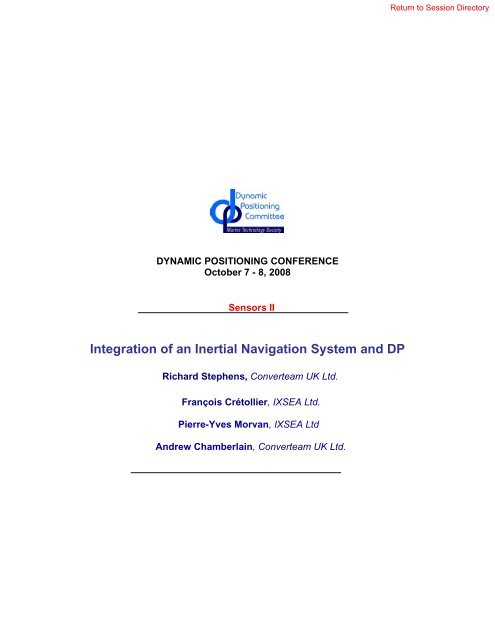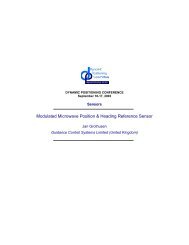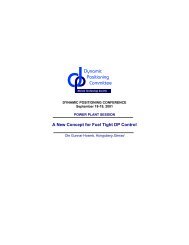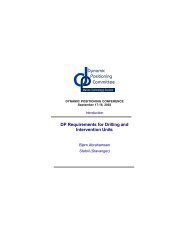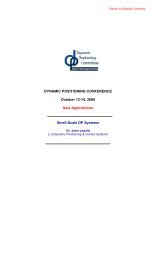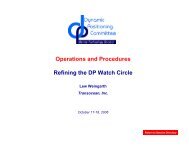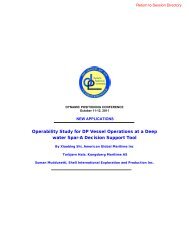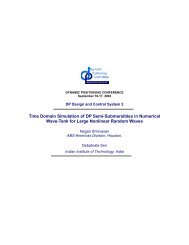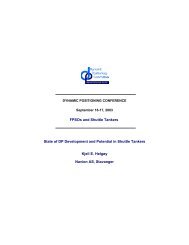Paper - Dynamic Positioning Committee of the MTS
Paper - Dynamic Positioning Committee of the MTS
Paper - Dynamic Positioning Committee of the MTS
You also want an ePaper? Increase the reach of your titles
YUMPU automatically turns print PDFs into web optimized ePapers that Google loves.
Return to Session DirectoryDYNAMIC POSITIONING CONFERENCEOctober 7 - 8, 2008Sensors IIIntegration <strong>of</strong> an Inertial Navigation System and DPRichard Stephens, Converteam UK Ltd.François Crétollier, IXSEA Ltd.Pierre-Yves Morvan, IXSEA LtdAndrew Chamberlain, Converteam UK Ltd.
R I Stephens et al Sensors II Integration <strong>of</strong> INS and DPABSTRACTThe paper describes an architecture for <strong>the</strong> integration <strong>of</strong> an inertial navigation system (INS) into adynamic positioning (DP) system. It discusses <strong>the</strong> major benefits <strong>of</strong> using INS for DP, and includes <strong>the</strong>results <strong>of</strong> sea-trials conducted to show <strong>the</strong>se benefits.There are a number <strong>of</strong> possible benefits to using an INS as an input to <strong>the</strong> DP system. These benefits aredependent upon a range <strong>of</strong> factors including <strong>the</strong> operations being undertaken by <strong>the</strong> vessel, <strong>the</strong> ease <strong>of</strong> useand <strong>the</strong> quality <strong>of</strong> <strong>the</strong> equipment.One use <strong>of</strong> an INS is to supplement or clean-up measurements from an existing measurement system. Bycoupling <strong>the</strong> INS to a hydro-acoustic system <strong>the</strong> INS can help to reduce <strong>the</strong> noise on <strong>the</strong> measurementsand fill-in for long update rates, for example, to prolong battery life for transponders.A fur<strong>the</strong>r use is to act as an independent position measurement system in <strong>the</strong> event <strong>of</strong> outages. In thisconfiguration <strong>the</strong> INS can provide position measurements during short outages (up to a few minutes) <strong>of</strong>all o<strong>the</strong>r PMEs.In order to gain <strong>the</strong> greatest advantage, <strong>the</strong> integration <strong>of</strong> <strong>the</strong> INS with <strong>the</strong> DP system is key. A flexiblearchitecture allows <strong>the</strong> INS to be used to its full potential. The architecture described allows INS-DPintegration that is easy to install and maintain and also allows dynamic reconfiguration to make <strong>the</strong> most<strong>of</strong> <strong>the</strong> available PMEs or to provide <strong>the</strong> greatest advantage for a particular application.The paper fur<strong>the</strong>r describes sea-trials performed to assess <strong>the</strong> ability <strong>of</strong> an INS system to provide <strong>the</strong>advantages described above. They include full-scale trials <strong>of</strong> INS performance at sea with a number <strong>of</strong>GPS outages. Also, performance <strong>of</strong> INS with acoustics-only is assessed from real-life data on a trialvessel.INTRODUCTIONThe vendors, owners and operators <strong>of</strong> DP systems are continuously striving to improve <strong>the</strong> safety,availability and efficiency <strong>of</strong> <strong>the</strong>ir systems. One area particular interest is in <strong>the</strong> position measurementequipment or PMEs. The operation <strong>of</strong> a DP system is <strong>of</strong>ten critical: lives depend upon it. It is <strong>the</strong>reforeimperative to have reliable measurements <strong>of</strong> position. For safety critical operations, physical redundancy<strong>of</strong> measurement systems is a legal requirement. Specifically, three independent measurement systemsmust be employed for Class III operation in which life is at risk: where “independent” means having nocommon mode <strong>of</strong> failure.The measurement <strong>of</strong> heading is usually achieved using one or more gyrocompasses. These devices havea long history, are reliable and accurate. Physical redundancy with independence is achieved by simplyadding more units.DP Conference Houston October 7-8, 2008 Page 2
R I Stephens et al Sensors II Integration <strong>of</strong> INS and DPPosition measurement systems utilize <strong>the</strong> global positioning systems (GPS) (Parkinson and Spilker,1995), acoustics, taut wires, optical methods and o<strong>the</strong>rs (Faÿ, 1990). Independence between positionmeasuring equipment (PME) is more difficult. For example, GPS systems are susceptible to disturbancesin <strong>the</strong> ionosphere, so different GPS receivers cannot be considered to be independent.The use <strong>of</strong> inertial navigation systems (INS) to provide an enhanced measurement system has beenproposed (Vickery, 1999). Inertial navigation systems use measurements <strong>of</strong> acceleration to estimate <strong>the</strong>motion <strong>of</strong> a vessel in an inertial reference frame. However, due to physical processes associated with <strong>the</strong>acceleration due to gravity, plus inherent accuracy and noise within <strong>the</strong> device itself, a degree <strong>of</strong> drift on<strong>the</strong> position measurements will always be present (King, 1998). Hence <strong>the</strong>re is a need for periodicupdates to <strong>the</strong> INS estimates <strong>of</strong> drift. These updates can come from ano<strong>the</strong>r position measurementsystem, for example, GPS or a hydro-acoustic system.There are clear advantages with using an INS to supplement a hydro-acoustic positioning system (Paturel,2004, Faugstadmo and Jacobsen, 2003). These include improving position accuracy in deep water,increasing battery life by allowing reduced 'ping' rates, and providing short-term fill-in for outages.The claimed benefits <strong>of</strong> INS have not been tested in action, however. This paper presents some livetesting using combinations <strong>of</strong> INS, GPS and ultra-short baseline (USBL) hydro-acoustics in an attempt toevaluate <strong>the</strong> potential gains.The full potential <strong>of</strong> <strong>the</strong> INS system can only be realized with an approach to <strong>the</strong> architecture <strong>of</strong> <strong>the</strong> wholeDP system. Proposed architectures are discussed in a later section.INS AND ACOUSTICSThe problems <strong>of</strong> deep-water acoustics are well known (Stephens, 2004). The depth introduces long pingcycle times due to <strong>the</strong> distance for <strong>the</strong> sound to travel, unless so-called ping stacking is employed. Deepwater also increases <strong>the</strong> cost <strong>of</strong> replacing batteries in transceivers, which starts to become a significantproportion <strong>of</strong> <strong>the</strong> overall cost <strong>of</strong> <strong>the</strong> system. By increasing ping cycle times <strong>the</strong> battery life can beextended. Ping stacking only serves to reduce <strong>the</strong> battery life. Unfortunately, <strong>the</strong> increased ping timescan adversely affect <strong>the</strong> DP control. This is true even though it is straightforward to configure <strong>the</strong> DPKalman filter controller to make use <strong>of</strong> long measurement update rates. It tends to lead to higher thrustusage as <strong>the</strong> DP system detects deviations later and has to apply greater adjustments in thrust. Anychanges in environmental forces or small inconsistencies in <strong>the</strong> DP’s vessel model are exacerbated by along ping time. There is also <strong>the</strong> possibility that aliasing effects due to long position measurementperiods will introduce increased noise into <strong>the</strong> position measurements.With an integrated INS, <strong>the</strong> long ping times can be reduced by using <strong>the</strong> INS to fill-in between pings.DP Conference Houston October 7-8, 2008 Page 3
R I Stephens et al Sensors II Integration <strong>of</strong> INS and DPIn order to investigate <strong>the</strong> benefits <strong>of</strong> this approach, a number <strong>of</strong> tests have been conducted on a two smallvessels utilizing an IXSEA hydro-acoustic system, combined with a PHINS inertial sensor. The testswere performed in USBL mode in 15 m water depth <strong>of</strong>f Brest, and in 1000 m water depth <strong>of</strong>f La Ciotat,on <strong>the</strong> south coast <strong>of</strong> France. In <strong>the</strong> deeper water, <strong>the</strong> shortest ping cycle time, without ping stacking, was3 s, <strong>the</strong>refore data was collected at that rate. Both raw acoustic data and PHINS corrected positions werelogged. An additional signal was generated from <strong>the</strong> PHINS using acoustic measurements sampled every21 s ra<strong>the</strong>r than 3 s.While it was not possible to install a DP system on <strong>the</strong> vessel in <strong>the</strong> time-scale <strong>of</strong> <strong>the</strong> trials, <strong>the</strong> resultshave been post-processed using a simulation <strong>of</strong> <strong>the</strong> DP to estimate <strong>the</strong> behavior <strong>of</strong> a DP vessel under <strong>the</strong>same conditions. The measured errors from <strong>the</strong> INS trials have been imposed on <strong>the</strong> simulation andcomparisons made between raw acoustic signals at 21 s updates and acoustics plus INS.The following figures show some results <strong>of</strong> such a simulation. Figure 1 shows a comparison <strong>of</strong> <strong>the</strong> vesselposition errors during <strong>the</strong> simulation runs. It shows that <strong>the</strong> position keeping is significantly improved byusing <strong>the</strong> INS corrections. The standard deviation <strong>of</strong> X-axis errors for acoustics only is 6.8 m while usingINS reduces this to 3.4 m.X-axis deviation (m)3020100-10Simulated position deviationsAcous+PHINSAcoustics-200 500 1000 1500 2000 250020Y-axis deviation (m)100-10-200 500 1000 1500 2000 2500Time (s)Figure 1 – position errors 21 s acoustics with/without INS in-fillThis provides a better balance between <strong>the</strong> respective weights <strong>of</strong> <strong>the</strong> INS+Acoustics and DGPS in <strong>the</strong> DPsystem, as <strong>the</strong> INS+Acoustics data is more accurate and comes at a higher recurrence than <strong>the</strong> pureacoustic data. This feature provides additional robustness to <strong>the</strong> full system.DP Conference Houston October 7-8, 2008 Page 4
R I Stephens et al Sensors II Integration <strong>of</strong> INS and DPAn even greater improvement is achieved in <strong>the</strong> thrust demands from <strong>the</strong> DP system for <strong>the</strong> samescenario. Figure 2 compares <strong>the</strong> thrust demands with and without <strong>the</strong> INS corrections. It shows thatthruster usage is dramatically reduced when <strong>the</strong> INS is filling-in between pings.X thrust (kN)5000Simulated thrust demandsAcous+PHINSAcoustics-5000 500 1000 1500 2000 2500500Y thrust (kN)0-5000 500 1000 1500 2000 2500Time (s)Figure 2 – thrust demands for 21 s acoustics with/without INS in-fillThis reduction in <strong>the</strong> thrust demand variation means less mechanical fatigue, less wear and reducedmaintenance. Ano<strong>the</strong>r consequence is a reduction <strong>of</strong> <strong>the</strong> thruster-generated noise in <strong>the</strong> water, whichmeans better acoustic detection through an improved signal to noise ratio, not only providing moreaccurate and secure acoustic positioning, but also enabling operations in deeper waters.A fur<strong>the</strong>r illustration is gained by comparing <strong>the</strong> fuel consumption during DP. By estimating thruster1.5power, P, from thrust, T, using <strong>the</strong> approximate relationship: P ∝ T , <strong>the</strong> relative fuel consumption canbe estimated (Lewis, 1988). Figure 3 shows <strong>the</strong> evolution <strong>of</strong> relative fuel consumption calculated in thisway. It reveals that <strong>the</strong> INS can reduce fuel consumption by a factor <strong>of</strong> five or more.DP Conference Houston October 7-8, 2008 Page 5
R I Stephens et al Sensors II Integration <strong>of</strong> INS and DP54.5Acous+PHINSAcousticsSimulated relative fuel consumption4Relative fuel consumption3.532.521.510.500 500 1000 1500 2000 2500Time (s)Figure 3 – Relative fuel consumption with/without INS in-fillINS AND GPSWhereas using INS with acoustics has obvious advantages, <strong>the</strong> use <strong>of</strong> INS with GPS (includingdifferential GPS) is less clear. There are five possible benefits: replacement <strong>of</strong> differential corrections,detection <strong>of</strong> GPS failures, removal <strong>of</strong> erroneous ‘jumps’, ride-through for temporary outages, and reducedthrust demand implying lower fuel consumption in nominal operation. These possibilities areinvestigated in <strong>the</strong> following sections.Replacement <strong>of</strong> differential correctionsIn order to assess <strong>the</strong> possibility <strong>of</strong> replacing <strong>the</strong> differential corrections in <strong>the</strong> DGPS with an INS, datawas logged on a stationary DGPS receiver in Rugby. The DGPS and GPS outputs were compared to givea differential correction, see Figure 4. It is clear from <strong>the</strong> figure that use <strong>of</strong> an INS for this purpose isimpractical due to <strong>the</strong> frequency (< 0.01 Hz) <strong>of</strong> <strong>the</strong> differential corrections.DP Conference Houston October 7-8, 2008 Page 6
R I Stephens et al Sensors II Integration <strong>of</strong> INS and DP1.2Differential corrections10.8North correction (m)0.60.40.20-0.2-0.40 1000 2000 3000 4000 5000 6000 7000 8000 9000 10000Time (s)Figure 4 – differential corrections for stationary receiverDetection <strong>of</strong> GPS failures and jumpsThis section investigates <strong>the</strong> possibility <strong>of</strong> using INS for detection <strong>of</strong> GPS failures and removal <strong>of</strong> jumps.A common occurrence using (D)GPS is a jump in <strong>the</strong> position estimate. This can occur when <strong>the</strong> visiblesatellite constellation changes, ei<strong>the</strong>r as <strong>the</strong> result <strong>of</strong> satellites rising or setting, or due to shielding fromnearby objects. Typical examples <strong>of</strong> <strong>the</strong> latter include passing under a bridge or approaching a platform.These jumps are <strong>of</strong>ten negligible, but sometimes become significant. For example, Figure 5 shows ashort jump <strong>of</strong> about 3 m and a short outage <strong>of</strong> about 15 s, which occurred in open water in <strong>the</strong> North Sea.The severity <strong>of</strong> a jump depends upon <strong>the</strong> operational situation <strong>of</strong> <strong>the</strong> vessel. Under most conditions ajump <strong>of</strong> 3 m is not problematic. During a close approach to a platform or o<strong>the</strong>r vessel, however, evensmall jumps can be ‘uncomfortable’. The DP system includes algorithms for error detection, includingdetection <strong>of</strong> noise, jumps and drift (Stephens, 2004). Though <strong>the</strong>se algorithms are sophisticated in <strong>the</strong>irown way, <strong>the</strong> most reliable forms <strong>of</strong> error detection rely on comparison <strong>of</strong> two, three or more PMEs. TheINS, as it is not based on a model but on real acceleration measurements, not only acts as a ‘filter’ on <strong>the</strong>DGPS measurements, but also rejects data during short term jumps, and fills-in for short outages. Thenext section examines <strong>the</strong> performance <strong>of</strong> <strong>the</strong> INS during long outages.DP Conference Houston October 7-8, 2008 Page 7
R I Stephens et al Sensors II Integration <strong>of</strong> INS and DP4DGPS jump3.5RawPme1 Position N [m]32.521.510.519:27 19:28 19:29 19:30 19:31TimeFigure 5 – DGPS jump in open waterThrust demand and fuel consumptionUse <strong>of</strong> a high-quality INS in conjunction with a DGPS receiver reduces <strong>the</strong> level <strong>of</strong> high-frequency noiseon <strong>the</strong> measured position. This has <strong>the</strong> effect <strong>of</strong> reducing <strong>the</strong> noise on <strong>the</strong> thruster demands, in <strong>the</strong> sameway as <strong>the</strong> INS reduced <strong>the</strong> noise <strong>of</strong> <strong>the</strong> acoustics in <strong>the</strong> previous section. In <strong>the</strong> case <strong>of</strong> <strong>the</strong> DGPS, <strong>the</strong>effect is less dramatic since <strong>the</strong> noise is initially smaller. This reduction <strong>of</strong> noise is not <strong>the</strong> same asfiltering: filtering introduces extra phase-lag into <strong>the</strong> control system whereas <strong>the</strong> INS is enhancing <strong>the</strong>position accuracy <strong>of</strong> <strong>the</strong> measurements without introducing lag.Sea trials have been conducted on a 7000 t vessel utilizing a Converteam DP system and PHINS withDGPS. For part <strong>of</strong> <strong>the</strong> trial, <strong>the</strong> vessel was held in a constant position under full DP control with DGPSas <strong>the</strong> only PME, followed by a period with DGPS+PHINS as <strong>the</strong> only PME. Figure 6 shows <strong>the</strong> thrusterdemands for <strong>the</strong> X and Y axes during <strong>the</strong> two periods <strong>of</strong> operation. There is noticeably more noise on <strong>the</strong>DGPS only data.DP Conference Houston October 7-8, 2008 Page 8
R I Stephens et al Sensors II Integration <strong>of</strong> INS and DPX demands (kN)151050-5DP thrust demands using DGPS with/without INSDGPS+PHINSDGPS-100 100 200 300 400 500 60020Y demands (kN)100-10-20-300 100 200 300 400 500 600Time (s)Figure 6 – thrust demand using DGPS with/without INSIn order to compare <strong>the</strong> expected fuel consumption with and without <strong>the</strong> INS corrections, <strong>the</strong> thrust1.5demands were used to estimate a relative fuel consumption using <strong>the</strong> relationship P ∝ T as before. Theresults <strong>of</strong> <strong>the</strong> estimation, for <strong>the</strong> 10 min periods <strong>of</strong> <strong>the</strong> trial are shown in Figure 7. The system without <strong>the</strong>INS uses 40% more fuel than DGPS+INS.1.41.2DGPS+PHINSDGPSEstimated relative fuel consumptionRelative fuel consumption10.80.60.40.200 100 200 300 400 500 600Time (s)Figure 7 – estimated fuel consumption using DGPS with/without INSDP Conference Houston October 7-8, 2008 Page 9
R I Stephens et al Sensors II Integration <strong>of</strong> INS and DPOUTAGE RIDE-THROUGHWith sunspot activity increasing towards a maximum in 2012 or 2013, <strong>the</strong> likelihood <strong>of</strong> ionosphericscintillation will be increasing for <strong>the</strong> next few years. The Holy Grail for DP operators is an alternativemethod for measuring a vessel’s position that is independent <strong>of</strong> <strong>the</strong> external influences. The usefulness <strong>of</strong>an INS during an outage <strong>of</strong> o<strong>the</strong>r PMEs depends on its drift. This drift is a function <strong>of</strong> inertialmeasurement unit (IMU) quality, calibration and correction. The short term accuracy <strong>of</strong> an INS derivesfrom <strong>the</strong> accuracy <strong>of</strong> its accelerometers, while <strong>the</strong> longer term accuracy derives from <strong>the</strong> gyro accuracy(Gaiffe, 2006). The position is defined by <strong>the</strong> double integration <strong>of</strong> <strong>the</strong> accelerometers, so <strong>the</strong> positiondrifts according to <strong>the</strong> square <strong>of</strong> time and <strong>the</strong> stability <strong>of</strong> <strong>the</strong> accelerometers. .Previously, outage data has been obtained for a stationary INS device (Paturel, 2004). Clearly, on a seabornevessel <strong>the</strong> INS will never be stationary. A series <strong>of</strong> tests were <strong>the</strong>refore carried out using a GPSunit and an INS in constant oscillatory motion, simulating bad wea<strong>the</strong>r. During <strong>the</strong> tests, <strong>the</strong> GPS input to<strong>the</strong> INS was removed at regular intervals and <strong>the</strong> positions <strong>of</strong> <strong>the</strong> INS and GPS compared over a period <strong>of</strong>‘outage’. Typical results from <strong>the</strong>se tests are shown in Figure 8 and Figure 9. Figure 8 shows <strong>the</strong>evolution <strong>of</strong> <strong>the</strong> INS drift with time. The results compare well with previous investigations <strong>of</strong> stationarysystems.25INS drift during GPS outages2015Drift (m)10500 50 100 150 200 250 300Time from loss <strong>of</strong> GPS (s)Figure 8 – evolution <strong>of</strong> INS drift during outages <strong>of</strong> 300 s and 120 sFigure 9 shows <strong>the</strong> distribution <strong>of</strong> <strong>the</strong> errors after 120 s and after 300 s. The distribution <strong>of</strong> drift errorsexhibit <strong>the</strong> shape <strong>of</strong> <strong>the</strong> Rayleigh distribution (Papoulis, 1984), which is characteristic <strong>of</strong> processesDP Conference Houston October 7-8, 2008 Page 10
R I Stephens et al Sensors II Integration <strong>of</strong> INS and DPformed from <strong>the</strong> sum <strong>of</strong> squares <strong>of</strong> Gaussian distributed sources – because <strong>the</strong> drift distance is <strong>the</strong> sum <strong>of</strong>squares <strong>of</strong> <strong>the</strong> deviations in North and East directions.10Frequency distribution <strong>of</strong> drift during outagesNo. <strong>of</strong> occurrences500 0.5 1 1.5 2 2.5 3 3.5 4 4.5 5Drift after 120 s (m)10No. <strong>of</strong> occurrences500 5 10 15 20 25Drift after 300 s (m)Figure 9 – distribution <strong>of</strong> INS drift after outages <strong>of</strong> 120 s and 300 sHow does <strong>the</strong> drift exhibited by <strong>the</strong> INS relate to expected motion <strong>of</strong> <strong>the</strong> vessel with no PMEs? To get anidea <strong>of</strong> <strong>the</strong> relative drifts <strong>of</strong> a vessel with no PMEs and one using only INS, we can estimate <strong>the</strong> forcerequired to move a vessel <strong>of</strong>f-station by <strong>the</strong> same amount as <strong>the</strong> observed INS drift. Taking <strong>the</strong> worstcase from Figure 8, distance travelled s = 22 m after time t = 300 s, <strong>the</strong> equivalent constant acceleration,a, can be calculated from2−4a = 2s/ t = 4.9 × 10 m/s 2 . For a typical supply vessel <strong>of</strong> displacement∇ = 4000 t, <strong>the</strong> force, F, required to achieve this acceleration would have been F = ∇a= 2. 0 kN. This isless than about 1% <strong>of</strong> <strong>the</strong> likely onboard thrust, suggesting that under moderate conditions, <strong>the</strong> vessel withno PMEs is likely to drift far more quickly than <strong>the</strong> INS. In addition, <strong>the</strong> drift <strong>of</strong> <strong>the</strong> INS is based on realphysical measurements <strong>of</strong> <strong>the</strong> accelerations, not on a model which would become degraded in case <strong>of</strong>non-nominal conditions like bad wea<strong>the</strong>r with large waves, or breaking <strong>of</strong> cables or an umbilical thatwould be linked to <strong>the</strong> platform.It should be noted that <strong>the</strong> intervals between <strong>the</strong> trials presented in Figure 8 – i.e. periods during which<strong>the</strong> DPGS was available again – were between 30 s and 300 s with no obvious difference between <strong>the</strong>two. This suggests that <strong>the</strong> self-alignment <strong>of</strong> <strong>the</strong> PHINS system is excellent, and <strong>the</strong> interval betweenoutages is unlikely to be a problem in practical situations.DP Conference Houston October 7-8, 2008 Page 11
R I Stephens et al Sensors II Integration <strong>of</strong> INS and DPDP SYSTEM ARCHITECTUREDue to its dependence on position measurements continually to estimate <strong>the</strong> errors in <strong>the</strong> accelerometers,we cannot treat an INS alone as an independent PME. It will always be dependent on one or more <strong>of</strong> <strong>the</strong>o<strong>the</strong>r PMEs. So, to keep independence between <strong>the</strong> PMEs, <strong>the</strong> INS should be tightly coupled with asingle PME, for example <strong>the</strong> acoustic system, see Figure 10. The DP system treats <strong>the</strong> combination as asingle PME. In this configuration it is important for information to be passed to <strong>the</strong> DP systemconcerning <strong>the</strong> quality <strong>of</strong> <strong>the</strong> INS/acoustic fix. For example, <strong>the</strong> DP should be warned if <strong>the</strong> INS loses <strong>the</strong>position measurements from <strong>the</strong> acoustic system. The same architecture can be utilized with <strong>the</strong> INS fedfrom a GPS.Figure 10 – normal architecture for INS with DPA development <strong>of</strong> an alternative architecture is shown in Figure 11. The INS obtains positionmeasurements from a number <strong>of</strong> PMEs, including GPS and acoustics. It is important that it uses only one<strong>of</strong> <strong>the</strong> position measurements at any one time to maintain its independence from <strong>the</strong> o<strong>the</strong>rs. Thisarchitecture <strong>of</strong>fers <strong>the</strong> main advantage <strong>of</strong> flexibility to <strong>the</strong> user, over <strong>the</strong> architecture <strong>of</strong> Figure 10. Theuser has <strong>the</strong> ability to choose between two possible configurations, depending on his application. Forinstance, if acoustics is required, <strong>the</strong> user can choose to use <strong>the</strong> INS+Acoustics configuration. O<strong>the</strong>rwise,he would select <strong>the</strong> INS+DGPS configuration.The status messages sent to <strong>the</strong> DP must include enough information for <strong>the</strong> DP to determine <strong>the</strong>configuration <strong>of</strong> <strong>the</strong> PMEs and INS. The DP must be able to ensure that <strong>the</strong> PME used in <strong>the</strong> INScalculations is not used in its own position estimates. The architecture <strong>of</strong> Figure 11 is already feasiblewith existing equipment. The PHINS equipment includes multiple input ports to allow for thisarchitecture.DP Conference Houston October 7-8, 2008 Page 12
R I Stephens et al Sensors II Integration <strong>of</strong> INS and DPFigure 11 – first alternative architecture using multiple inputs to INSA fur<strong>the</strong>r enhancement would be to move to <strong>the</strong> architecture <strong>of</strong> Figure 12. In this configuration, <strong>the</strong> INSgets its position measurements from <strong>the</strong> DP system, which selects <strong>the</strong> measurements from one <strong>of</strong> <strong>the</strong>existing PMEs. The selection logic must continue to ensure that <strong>the</strong> INS measurements are independent<strong>of</strong> <strong>the</strong> o<strong>the</strong>r PMEs by excluding <strong>the</strong> PME-only measurements from <strong>the</strong> ship position estimation – relyingon <strong>the</strong> INS corrected version. This configuration <strong>of</strong>fers a number <strong>of</strong> additional benefits:• The DP can automatically prevent rogue position measurements being passed to <strong>the</strong> INS bycomparing multiple PME measurements.• All <strong>the</strong> control/command <strong>of</strong> <strong>the</strong> full system during operation is accessible from <strong>the</strong> sole HMI <strong>of</strong><strong>the</strong> DP systemFigure 12 – proposed architecture for full integration <strong>of</strong> INS and DPIn this architecture, <strong>the</strong>re is no loop, as <strong>the</strong> DP system acts as a switch – it sends only PME data to <strong>the</strong>INS, not <strong>the</strong> pooled position estimate. The INS s<strong>of</strong>tware utilizes <strong>the</strong> estimated variances <strong>of</strong> <strong>the</strong> positionmeasurements to maintain covariance estimates <strong>of</strong> <strong>the</strong> states. These will differ for different PMEs. It isDP Conference Houston October 7-8, 2008 Page 13
R I Stephens et al Sensors II Integration <strong>of</strong> INS and DPnecessary, <strong>the</strong>refore, to include information on <strong>the</strong> PME being used in <strong>the</strong> communication channel from<strong>the</strong> DP to <strong>the</strong> INS.Acoustics with INSWith most acoustic systems on <strong>the</strong> market, <strong>the</strong> above architectures would require a PHINS as astandalone INS. There is one exception with <strong>the</strong> GAPS, which is an acoustic positioning system with anembedded INS, <strong>of</strong> <strong>the</strong> same class as <strong>the</strong> PHINS. This embedded INS can act as described above and thuscan provide an INS output to <strong>the</strong> DP system. The GAPS would <strong>the</strong>n be directly linked to <strong>the</strong> ConverteamDP system, without a requirement for an additional INS.Ease <strong>of</strong> useBoth PHINS and GAPS have a user friendly HMI. The integration is very much simplified as <strong>the</strong> PHINSis a standalone box with all computations performed internally, easy to set-up. The PHINS is IMOcertified (‘wheel-marked’) which means that it can act as a gyrocompass and motion sensor, moreover <strong>of</strong>a high grade type. The GAPS is also an all-in-one calibration-free package that does not need an accurateand expensive hoisting system as <strong>the</strong> internal INS compensates for its own movements.The ease <strong>of</strong> use <strong>of</strong> <strong>the</strong> INS is a major factor in its usefulness on board a vessel. Both PHINS and GAPSare easy to operate, and do not require expert personnel onboard. This equipment is now widely used,and operated by <strong>the</strong> vessel staff.Finally, <strong>the</strong> PHINS is – and GAPS includes – an INS, which is very different from an IMU is <strong>the</strong> sensethat all <strong>the</strong> computation is performed inside <strong>the</strong> equipment so that no raw data <strong>of</strong> <strong>the</strong> inertial sensors isoutput, making it safe against <strong>the</strong> risk <strong>of</strong> diversion <strong>of</strong> use, like missile technology. With respect to exportrules – for operations abroad, or return to <strong>the</strong> factory for upgrade – <strong>the</strong> consequence is that PHINS andGAPS do not have all <strong>the</strong> limitations that face IMUs..CONCLUSIONSThe paper has investigated <strong>the</strong> use <strong>of</strong> an INS in DP operations. An INS can provide information aboutvessel position but due to natural drift it requires regular updates from ano<strong>the</strong>r PME. The paper hasinvestigated <strong>the</strong> performance <strong>of</strong> different applications including: INS with acoustics, INS with DGPS andride-through <strong>of</strong> outages. In order to increase confidence in <strong>the</strong> usefulness <strong>of</strong> INS, tests have beenperformed at sea using acoustics, and under constant motion on land.DP Conference Houston October 7-8, 2008 Page 14
R I Stephens et al Sensors II Integration <strong>of</strong> INS and DPA combination <strong>of</strong> data from sea trials and post-processing using simulation has shown that an INScoupled with acoustics in deep-water can be used to extend <strong>the</strong> ping interval, <strong>the</strong>reby saving battery life,and reduce fuel consumption by filling-in between pings.For INS with GPS, <strong>the</strong> replacement <strong>of</strong> differential corrections is not seen as a possibility, however, jumpsand short outages in GPS reception are fairly common and could be removed by an INS.The possibility <strong>of</strong> using INS to ride-through longer outages has been investigated using sea-trial data.Depending on <strong>the</strong> application and positioning accuracy, INS can provide a ride-through capability.Finally, a number <strong>of</strong> possible system architectures have been discussed in order to obtain <strong>the</strong> most reliableand useful configuration for <strong>the</strong> INS. An architecture which allows <strong>the</strong> DP to select <strong>the</strong> reference input to<strong>the</strong> INS has been proposed.ACKNOWLEDGEMENTSThe authors would like to thank <strong>the</strong>ir colleagues at Converteam and IXSEA for help and support during<strong>the</strong> sea trials and preparation <strong>of</strong> this paper. Also <strong>the</strong> owners and operators <strong>of</strong> <strong>the</strong> vessels used.REFERENCESFaugstadmo, J. E. and Jacobsen, H. P. (2003). “HAIN: An integrated acoustic positioning and inertialnavigation system”, <strong>MTS</strong> <strong>Dynamic</strong> <strong>Positioning</strong> Conference, 16-17 September 2003, Houston TX.Gaiffe, T. (2006). “From high technology to solutions: <strong>the</strong> experience <strong>of</strong> IXSea”, web-based article,http://www.ixsea.com/pdf/2006-oceans-singapore.pdf.King, A. D. (1998). “Inertial navigation - forty years <strong>of</strong> evolution”, GEC Review, 13(3), pp. 140-149.Lewis, E. V. (1988). Principles <strong>of</strong> Naval Architecture, Society <strong>of</strong> Naval Architects and Marine Engineers,Jersey City, NJ, USA.Papoulis, A. (1984). Probability, Random Variables, and Stochastic Processes, 2 nd edition, McGraw-Hill,New York.Parkinson, B. W. and Spilker, J. J. (Eds.) (1995). Global <strong>Positioning</strong> System: Theory and Applications,American Institute <strong>of</strong> Aeronautics and Astronautics, Washington DC, USA.Paturel, Y. (2004). “PHINS, an all-in-one sensor for DP applications”, <strong>MTS</strong> <strong>Dynamic</strong> <strong>Positioning</strong>Conference, 28-30 September 2004, Houston, TX.Stephens, R. I. (2004). “Aspects <strong>of</strong> industrial dynamic positioning: reality-tolerant control”, IFACConference on Control Applications in Marine Systems, CAMS 2004, 7-9 July 2004, Ancona, Italy,pp. 41-51.Vickery, K. (1999). “The development and use <strong>of</strong> an inertial navigation system as a DP position referencesensor (IPRS)”, <strong>MTS</strong> <strong>Dynamic</strong> <strong>Positioning</strong> Conference, 12-13 October 1999, Houston, TX.DP Conference Houston October 7-8, 2008 Page 15


